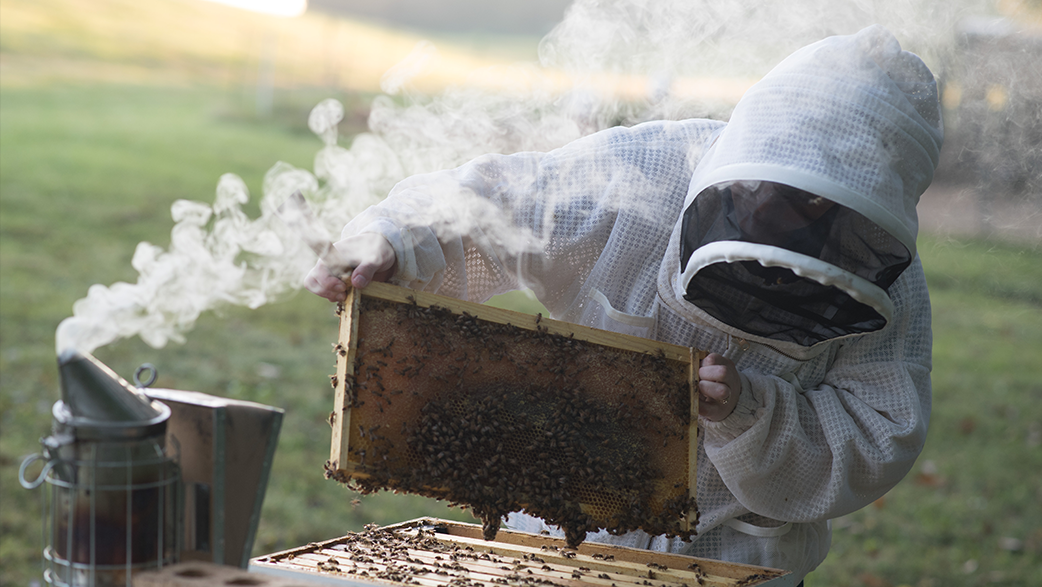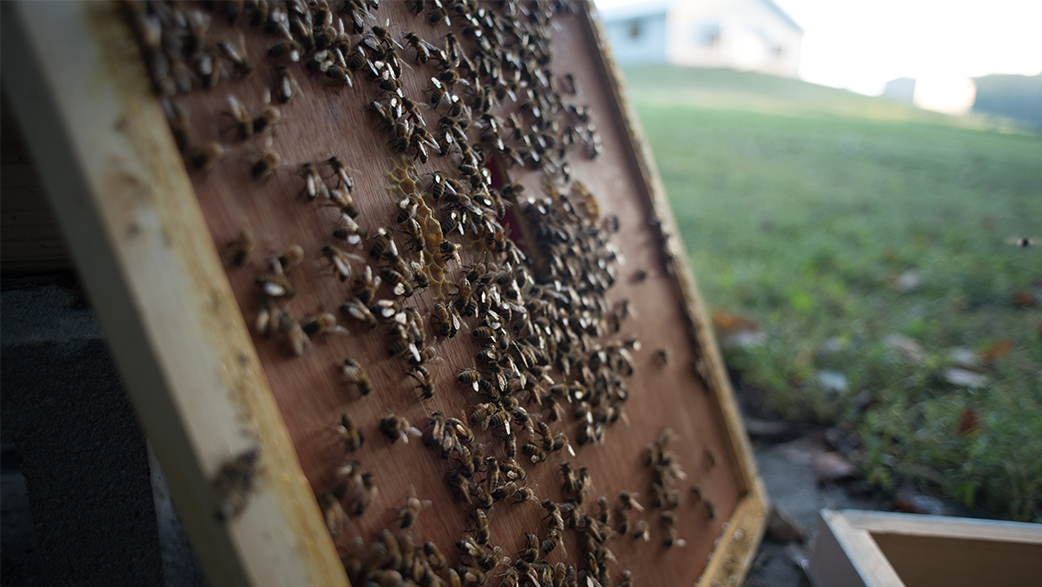Grace Kunkel is taking calls from the honey bee hives this afternoon. Set a little way back from the barns, it’s peaceful in the sunny field, apart from the occasional curious bee doing a fly by.
“One almost dinged me!” she says. “But it’s beautiful out here. I have two people helping me in the field today. We’re a new team and we’re growing. But I find myself being pretty hands-on at times, taking care of the bees.”
As a research scientist, Grace’s job is to plan and run research trials at the Purina Animal Nutrition Center in Gray Summit, Missouri. Each of the farm’s three honey bee sites house about 20 and 30 colonies, with about 40,000-60,000 bees per colony. That’s a few million bees if you’re counting. Feeding and caring for them all is a year-round job that keeps this researcher busy as, well, a bee.
And Grace is about to get even busier. This fall, the Purina team will be launching a first-of-its-kind product—Purina® Hearty Bee™, a supplement meant for use by commercial beekeepers.
“This is my first product launch!” says Grace. “After being at Purina for two years, and seeing how far this whole project has come, I feel very proud to be involved. I’ve learned so much about marketing and had the chance to help develop the marketing plan and materials. It’s all new to me and I’m loving it.”

Breaking into bees
Grace didn’t grow up thinking she’d have a career studying bees, let alone working for a feed company. Initially, she wanted to be a veterinarian. That’s how she found herself at the University of Maryland pursuing a biology major.
“I happened to take an entomology course and liked it. Turns out, I was weirdly good at identifying insects,” she says. “I didn’t have any idea this was something a person could do as a career, but my professor hired me to work in the entomology department, and I decided to take a course.”
At first, the choice was a head scratcher for her parents. They were worried she’d get stung, but they soon saw how passionate she was.
“I remember the first time I helped with a colony. Bees can be very loud when there are 50,000 in one box in front of you,” Grace says. “The course was taught by a retired bee keeper. He made it no big deal, and even encouraged us not to wear gloves. You’re less clumsy and you can feel what’s going on. You learn how to get comfortable in your suit and not be afraid. It’s all about staying calm.”
She ended up completing her Master of Science in Entomology. This was right around the time colony collapse was hitting the news. She worked at the university for a few more years, and then, an opportunity came from an unexpected place.
“A job for a honey bee research scientist at Purina was circulated around our department,” she says. “Gray Summit wasn’t too far from my family home and I’d been looking for new opportunities. My boyfriend at the time, now husband, had a feeling it could work. I applied and three months later, we were moving to St. Louis.”
The Purina Animal Nutrition Center, affectionately called “the farm,” is a 1,200-acre working farm located just west of St. Louis. This is where our where our animal nutrition (think animal feed) research happens. Not counting the bees, the farm’s 3,000 animals from a variety of species are cared for by 100 people. More than 24,000 animal nutrition research studies have been conducted onsite. What we learn through these trials helps us help animals reach their full potential.
Grace arrived at the farm in the summer of 2015, just in time for Missouri’s wettest June on record. That made her work particularly challenging. Bees are sensitive, and so are research trials.
“I joke that I wasn’t there when my baby was born,” she says. “The bees got put in two weeks before I started. Then, it rained almost every day, and I had a hard time keeping those bees healthy. Or I might have planned to take samples on a certain day, but if it’s raining, that’s not a good day to go out to the hive.”

The pollinator situation
Bee, butterfly and other native pollinator populations have recently experienced notable declines. Research points to a variety of causes, including habitat loss, pests and disease, pesticides, climate change and a lack of proper nutrition.
Commercial honey bee keeping is critical to the food and agricultural industries. Although most grains are pollinated by the wind, crops such as fruits, nuts and vegetables rely on pollinators. So, farmers contract to have honey bee hives placed on their property. It’s a relatively small community of 1,000 – 1,500 commercial bee keepers supplying bees across the country.
On the farms, the bees do their thing and pollinate the farmers’ crops. Bee keepers need to provide a certain number of bees to hold up their end of the contract, and if bees have a hard time finding enough food, they can’t maintain their populations.
Think about the white boxes that make up a hive. Each box has 10 frames. When you look at a frame, you can measure about how full it is, and therefore can estimate how many bees are in the hive. A farmer might contract to have six frames per box on average, and pay a little extra if they get an average of seven.
For the bee keepers, the cost of keep a colony alive and well has gone up, and it’s becoming more of a challenge. Many beekeepers end up feeding their bees sugar syrup. Grace says this added expense is reflected in the increasing cost to rent a colony for almond pollination, for example.
“It’s tricky,” says Grace, “with honey bees specifically, because they are an agricultural commodity. They are very closely tied to our food source. We know lack of forage and habitat is one problem, and we don’t even know how many different pollinator species we’ve lost. We do know that commercial honey bee hives are the easiest pollinators to study, and we know they need protein to keep reproducing their population.”
Introducing Purina® Hearty Bee™
Grace has been working on Purina® Hearty Bee™ since the beginning. The team wanted to create a better way to provide protein to commercial honey bees.
To understand how the supplement performed, she monitored the bees through their 3-week brood cycles. A few cycles make up a trial, which last 3 months on average. Last year she did a lot of attractant work. Essentially, it’s testing what scents bees like best.
This finished bee feed supplement has the consistency of cookie dough and the unique ability to mix into a liquid. The liquid can then be placed inside the colony under the lid, or in a feeder designed to deliver liquid to bees.
“Hearty Bee is a dry supplement meant to mix with sugar syrup. This, along with it’s small, consistent particle size, makes it easier for bees to eat,” says Grace. “It’s meant for when bees don’t have access to pollen, their natural protein source. The supplement gives them the nutrition they need to maintain their populations. And we’re targeting commercial honey bee keepers because they have the most bees. We’re going where the bees are.”
Hearty Bee™ will hit the commercial bee keeping market this September, making it the first honey bee feed available from Purina. Grace will tell you the process from idea to market was a group effort.
“I’m the first honey bee research scientist here, and I think that’s unique. Purina is a feed company. A lot of the other supplements in the marketplace are from beekeeping companies. But I think we have an advantage,” says Grace. “When I’m on the farm, talking to other researchers about the cool things they are doing and how much they know about their animals, I think we’re a little behind in the honey bee industry—but I think the Purina team can fix that.”